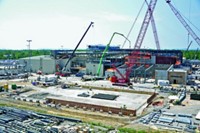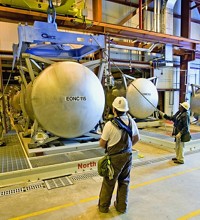Advertisement
Grab your lab coat. Let's get started
Welcome!
Welcome!
Create an account below to get 6 C&EN articles per month, receive newsletters and more - all free.
It seems this is your first time logging in online. Please enter the following information to continue.
As an ACS member you automatically get access to this site. All we need is few more details to create your reading experience.
Not you? Sign in with a different account.
Not you? Sign in with a different account.
ERROR 1
ERROR 1
ERROR 2
ERROR 2
ERROR 2
ERROR 2
ERROR 2
Password and Confirm password must match.
If you have an ACS member number, please enter it here so we can link this account to your membership. (optional)
ERROR 2
ACS values your privacy. By submitting your information, you are gaining access to C&EN and subscribing to our weekly newsletter. We use the information you provide to make your reading experience better, and we will never sell your data to third party members.
Environment
Chemical Arms Disposal In Russia
Construction of critical chemical weapons destruction facility at Shchuch'ye is back on track
by Lois R. Ember
October 22, 2007
| A version of this story appeared in
Volume 85, Issue 43

RUSSIA HAS SET a Herculean task for itself: destroy its massive chemical weapons stockpile by 2012, even though it has yet to destroy even a quarter of its arsenal.
As recently as August, a senior Russian defense official reaffirmed his country's intention to meet its treaty obligations under the Chemical Weapons Convention and get rid of its 40,000-metric-ton arsenal by 2012 at an estimated cost of $7 billion. This cost is about five times less than current estimates for completely eliminating the U.S.'s much smaller chemical arsenal of less than 30,000 metric tons.
Russia selected neutralization as its primary method for destroying chemical agents, eschewing the U.S.'s primary method, incineration. The choice of neutralization plus the decision to treat most of the secondary waste with bituminization, an encapsulation process, account for Russia's lower cost estimates.
Despite the simpler route to destruction, Russia "will likely fail" to destroy its arsenal by 2012, the U.S. Government Accountability Office concluded in a report last year. To date, Russia has destroyed only 22% of its stockpile and will not reach a treaty milestone of 45% until December 2009. It has yet to build four of seven planned destruction facilities.
The U.S. has pledged $1.04 billion in so-called Nunn-Lugar funds to help build one of those four disposal facilities, at Shchuch'ye. Shchuch'ye lies in a remote, impoverished agricultural region east of the Ural Mountains in the westernmost part of the Siberian steppes.
This is the largest single project funded under the Nunn-Lugar Cooperative Threat Reduction (CTR) program to help Russia eliminate its weapons of mass destruction. Oversight of CTR projects is the responsibility of the Defense Department.
The Shchuch'ye stockpile of a little more than 5,400 metric tons accounts for about 14% of Russia's total chemical arsenal. This 14%, however, consists of 2 million portable artillery shells filled with the deadly nerve agents VX, soman, and sarin.

The weapons' portability and the dire economic straits of the local population made the largely unsecured stockpile a tantalizing target for theft and diversion to a region south of Russia that is home to known terrorist groups. In 1999, the U.S. felt that the threat of proliferation was so grave that it appropriated $10 million from the CTR program to shore up security at Shchuch'ye. Work to enhance security began in 2002 and was completed a year later.
Even today, the threat of diversion, though lessened, still exists. In a statement on his August visit to the site, former Georgia senator Sam Nunn said that the sheer number of shells "would make it hard to know if one was missing."
Sen. Richard Lugar (R-Ind.), who went on the same trip, concurred. "I am convinced," he said in a statement, "that the weapons stored here must be dismantled quickly and safely." He also stressed, as he has in the past, that "this project is essential to the national security of the U.S."
The sprawling Shchuch'ye destruction facility, about 10 miles north of the stockpile site, was scheduled to go on-line in the summer of 2008. But contracting disputes between the U.S. and Russia over the past several years have substantially delayed construction of the U.S.-built facility, one of two identical buildings where neutralization of the agents is to take place. The other is being built by the Russians (C&EN, Nov. 7, 2005, page 19).
Neutralization of chemical agents may begin in the Russian-built destruction facility in late 2008. But, even this date may be overly optimistic, says Paul F. Walker, director of Global Green USA's Legacy Program. Global Green USA is an affiliate of Mikhail Gorbachev's Green Cross International, which advocates for social justice and environmentally sustainable practices. Walker has been involved in the Shchuch'ye project since 1994 when, as a staff member of the House Armed Services Committee, he participated in an on-site inspection of the stockpile.
Start-up may be delayed not only because of the contracting dispute but also because of growing citizen dissatisfaction with the Russian government's broken promises. Most Shchuch'ye residents lack running water and gas in their ramshackle one-story wooden homes. Their roads are deeply rutted and flooded most of the year. There is no public transportation and no work to speak of except in the agricultural sector.
The government has made very little progress in upgrading the social infrastructure of the community, and the construction of the disposal facility has brought few hoped-for jobs to the mostly unskilled inhabitants. Increasing citizen frustration "could lead to major public protests," Walker and Cristian Ion, a Legacy Program associate, wrote in a June 2007 trip report.
Keeping Score
Under the extended deadline of the chemical weapons treaty, the U.S. has until December 2012 to destroy its chemical weapons stockpile. As of Oct. 3, the U.S. had destroyed 14,443 metric tons, or 50.3% of its 28,576-metric-ton arsenal. This contrasts sharply with the Russian program, which has destroyed only 21.6% of a much larger arsenal of 40,000 metric tons.
To date, the U.S. has met the treaty's milestones of 1, 20, and 45% dismantling of its stockpile. In fact, it met the extended 45% deadline of Dec. 31, 2007, six months early. Russia has only met the treaty's first two milestones but insists that it will meet the 2012 deadline. The U.S., on the other hand, estimates that it won't completely dismantle its smaller stockpile until 2023.
The U.S. has or had chemical weapons stored at nine sites and has built or plans to build destruction facilities at these sites; five are incineration plants and the remainder are or will be neutralization facilities. Two neutralization facilities, at Pueblo, Colo., and Richmond, Ky., remain to be built.
Russia plans to build seven destruction facilities-with the financial assistance of other countries-at its seven storage sites. To date, it has completed construction on only three facilities.
The U.S. has completely destroyed weapons at two of its nine storage sites. Using incineration, the U.S. eliminated the variety of chemical weapons stored on Johnston Atoll in the Pacific Ocean. Because mustard agent was stored in bulk 1-ton containers at Aberdeen Proving Ground's Edgewood site in Maryland, the U.S. opted for neutralization to destroy all of the agent stored there.
By contrast, Russia has completely eliminated weapons only at Gorny, one of seven storage sites. But even at Gorny, the neutralized agent has yet to undergo secondary treatment, so large amounts of toxic waste remain on-site.
AS FRUSTRATION and anger mount, Walker fears growing citizen protests could "block construction of the destruction facility." He tells C&EN, "All construction trucks pass through the village, so citizens could delay construction considerably by blocking those trucks."
Though citizen unrest remains, disagreements over the contracting issue seem to have been resolved and could speed up construction of the U.S.-funded neutralization facility.
The contracting backstory is somewhat convoluted, but in short it boils down to "the failure of the U.S. and Russia over the past two-and-a-half years to agree on fair and appropriate subcontracting," Walker explains. Russian subcontractors' bids on U.S. construction proposals "have been several times higher than what the U.S. and its prime contractor, Parsons Global Services, consider fair," he says.
In the spring of 2005, the U.S. asked for bids on installing equipment in the facility to punch and drain the shells and neutralize the released chemical agent. Parsons estimated the contract at around $60 million. Russian contractors came back with bids ranging from $100 million to well over $300 million.
In April or May of this year, the U.S. and Russia signed a bilateral agreement that turns over all remaining subcontracting to the Russians. Members of Congress and their staff have been briefed on the agreement, but no one C&EN contacted had actually seen it.
About $200 million of the $1.04 billion the U.S. committed for the Shchuch'ye facility has yet to be awarded. Under the bilateral agreement, Russia is responsible for any spending beyond the $200 million.
It is not clear how much it will eventually cost to build the U.S. destruction building, but Walker expects it will be a lot cheaper with Russia doing the subcontracting.
"The Russians have begun awarding contracts under the new agreement—about $20 million to date," says a State Department official familiar with the agreement who asks not to be named. "With U.S. providing the funding and the Russians doing the contracting, construction of the U.S. building should speed up," this official says. Parsons remains the U.S.'s prime contractor at Shchuch'ye responsible for oversight of the Russian work.
The Bush Administration has requested no additional CTR funding for Shchuch'ye in the fiscal 2008 defense request it sent to Congress. The House, however, has appropriated $42.7 million and the Senate $1 million in additional CTR funding for the destruction facility. A Senate staffer, who requested anonymity, says the two houses "will work out the differences in conference." Whatever compromise is reached will be in addition to the $1.04 billion Congress originally committed for Shchuch'ye. These additional funds will support Parsons' continued presence at the site to allow the contractor to "maintain accountability of U.S. taxpayers' dollars," Walker explains.
In its report accompanying the spending bill, the House concludes, "The elimination of chemical weapons anywhere they exist in the world, and the prevention of their proliferation, is of utmost importance to the national security of the U.S." More specifically, the Senate report reads: "One of the highest priorities in the CTR programs is to ensure that the facility to destroy Russian chemical munitions in Shchuch'ye, Russia, is completed."
To have any chance of meeting the 2012 treaty deadline, the Russians are expected to begin neutralizing chemical agent in their destruction building by the end of 2008. The contracting delays for the U.S. destruction facility means agents probably won't be neutralized in that building until 2011, Walker says.
But as Walker points out: "The key question is whether the Russians will wait until both buildings are completed and systematized to destroy agents. Or will they start neutralizing agents in their building in late 2008 while construction restarts on the U.S. neutralization facility?"
THE NUB of the issue is risk. "What," Walker asks, "is the risk to construction workers being exposed to live agent from the operating Russian building?" Taking such a risk "would never be allowed in the U.S."
Still, the State Department official says, "it is likely construction will still be going on in the U.S. building while destruction is going on in the Russian building." The Defense Threat Reduction Agency, the one agency that could have definitively answered questions about U.S. involvement at Shchuch'ye, refused C&EN's repeated requests for interviews. DTRA has prime responsibility for managing CTR programs.
"It is important for the U.S. to remain involved at Shchuch'ye to ensure that the weapons are destroyed safely and in a timely way and that they are not diverted to terrorists," Walker says. He believes that effort by Russia, the U.S., and others, including Canada and the U.K., to dismantle the deadly weapons at Shchuch'ye "is a keystone to the ongoing war on terror and nonproliferation efforts globally."






Join the conversation
Contact the reporter
Submit a Letter to the Editor for publication
Engage with us on Twitter